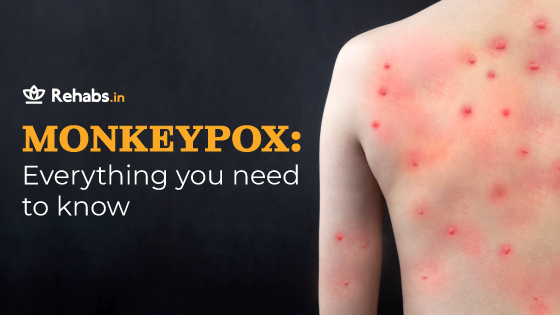Monkeypox: Everything you need to know

Even as we are still dealing with the physical, mental, social and economic impact of the coronavirus pandemic, the World Health Organization (WHO) has now raised concern over a new viral disease, monkeypox, which is spreading at an alarming rate around the world. India has currently reported 9 cases of monkeypox and one virus-related death.
Monkeypox is a rare disease caused by the Monkeypox virus, which is a viral zoonosis (a virus transmitted to humans from animals). The virus is part of the same family of viruses as the variola virus, the virus that causes smallpox. The symptoms of Monkeypox are similar to smallpox but less severe, and monkeypox is rarely deadly.
As per the latest statistics, over 30,000 confirmed cases of monkeypox had been reported in 88 countries, according to data available on cdc.gov. With the number of monkeypox cases rising in non-endemic countries, WHO, on July 24, 2022, declared monkeypox a global health emergency.
Is Monkeypox a new disease?
Monkeypox was first discovered in 1958 when two outbreaks of a pox-like disease occurred in colonies of monkeys kept for research. It is natural to assume that the virus originated from monkeys due to its name, but in truth, the source of the disease remains unknown. Animals that have been identified as susceptible to the monkeypox virus include rope squirrels, tree squirrels, Gambian pouched rats, dormice, non-human primates and other species.
Although you may have just heard about monkeypox, the first human case of monkeypox was recorded in 1970. In fact, many central and western African countries have reported monkeypox cases over the past many years where the virus is endemic.
Prior to the 2022 outbreak, most of the monkeypox cases in individuals outside of Africa were connected to international travel to countries where the disease commonly occurs or through imported animals from endemic countries.
How can you get infected by the monkeypox virus?
You can contact monkeypox if you come in close contact with an infected person or an infected animal. In human-to-human transmission, the virus can enter your body through broken skin, the respiratory tract or through the eyes, nose or mouth. You can also get infected if you come in contact with monkeypox lesions of an infected person, breathe in the respiratory droplets, or exchange bodily fluids with an infected person through kissing (open lesions inside the mouth) or sex (semen). Infected pregnant women can also transfer the virus to the fetus via the placenta. Monkeypox is still not considered an STD (Sexually Transmitted Disease), although people who have contracted the virus are advised to use condoms for at least eight weeks post being infected as an additional method of precaution.
Animal to human transmission of the virus can occur when the infected animal bites or scratches you. It’s still not clear whether house pets like dogs and cats can be infected, but the Centers for disease control and prevention (CDC) advises you to expect that any animal can contract the monkeypox virus. The CDC also believes that infected humans can spread the virus to their pets through petting, cuddling, kissing, licking, sharing food and sleep areas. People who have the virus are advised to stay away from people as well as animals (both domesticated and wild) until they have fully recovered.
Signs and symptoms of Monkeypox
One of the most common symptoms of monkeypox is the appearance of a rash. This rash usually appears within 1-3 days after your fever starts, and the rash typically starts on your face and then spreads to other body parts. The rash usually follows a particular pattern: Flat, round lesions (macules) that grow into slightly raised bumps (papules), which then turn into bumps filled with clear fluid (vesicles). Individuals can get anywhere from 10 to 150 bumps on their skin. The last stage of the rash is bumps with yellowish fluid (pustules) that crust over and fall off.
In a few cases, individuals have complained about pain around the anus, the urge to pass stools even though the gut is empty (tenesmus), bleeding in the lower part of the large intestine (rectum), and painful inflammation of the anus and rectum lining (proctitis). These symptoms can be linked to painful bumps in the area.
Other symptoms may also include fever, tiredness, headache, aching muscles, chills, backache, sore throat, dry cough and swollen lymph nodes. In severe cases, the infected person may even have trouble breathing.
Monkeypox symptoms usually show up within 2 to 3 weeks of exposure to the virus. If you have flu-like symptoms, then you can expect the appearance of a rash 1-4 days later. You can infect others with the virus starting a day before the rash shows up. Hence, it’s important to maintain social distance as soon as you get flu-like symptoms. You are contagious for up to 21 days after your first symptoms or until all your scabs have fallen off and a fresh layer of skin has formed, and you don’t have any other symptoms. Monkeypox illness typically lasts 2-4 weeks.
Treatment for Monkeypox
There is no precise treatment for monkeypox. Your doctor will ask you to stay isolated and to have plenty of fluids and over-the-counter medicines to keep other mild symptoms at bay. To control the current outbreak, doctors may turn to antivirals and vaccinia gamma globulin (made from the blood of individuals recently vaccinated against smallpox) as well as the smallpox vaccine.
If in the last 3-5 years you’ve had a recent smallpox vaccine, you may have some defence against monkeypox. As per multiple studies, the smallpox vaccine is 85% effective at preventing monkeypox. The U.S. has two vaccines to prevent smallpox, namely the ACAM2000 and JYNNEOS (Imvamune, Imvanex).
While it’s ideal to get vaccinated beforehand, getting vaccinated after exposure may still help you from catching the disease, or it can make the symptoms less severe. The CDC advises getting vaccinated within 4 days after exposure to monkeypox. Even if you miss this window frame, you should still go ahead and get the vaccine (up to 14 days after exposure), as it could still reduce your monkeypox symptoms. You may experience some minor reactions from smallpox or monkeypox vaccine, such as mild fever, fatigue, swollen glands and itching at the spot where the vaccination was administered.
Is monkeypox as contagious as Covid?
Covid or coronavirus is an airborne virus and hence far more contagious than monkeypox, which needs physical contact with the virus. Also, monkeypox infection develops after prolonged contact with an infected person (people in the farming industry working with infected animals, veterinarians, caregivers, doctors, etc.) If an infected person isolates himself for a period of 2-4 weeks, then there are almost nil chances of spreading the virus.
Monkeypox outbreak is also relatively easier to contain than SARS COV-2. The treatment for monkeypox has always been available in the form of smallpox vaccination, while for coronavirus, top medical minds had to work tirelessly for months to come up with a vaccination. Also, people with monkeypox have very visible symptoms in the form of rashes and hence can be isolated and treated immediately. On the other hand, the symptoms of coronavirus are hard to diagnose within the first weeks, which may cause the infected person to spread the virus to more people.
We are now living in times of pandemics and epidemics. Climate change, rapid urbanization, deforestation, animal migration, etc., are leading to more and more human and animal interactions. These interactions may cause pathogens present in animals to transfer to humans never before infected with those pathogens. This increased risk of cross-species pathogen transmission can lead to diseases, illnesses and contagious infections.
While you and I may have no control over these issues, we can protect ourselves by making certain lifestyle changes. It’s best to protect ourselves by wearing a protective mask around our face when we are out in a public space or travelling by public transport. Carry a sanitiser with you at all times and sanitize your hands and objects around you. It’s time to bring back the traditional way of greeting people with a “namaste” rather than shaking hands or hugging. When you are back home after an outing, wash your hands and legs and, if possible, take a shower as well. By maintaining proper hygiene at all times, you can keep yourself protected. Also, stay up-to-date with all your flu shots and see a doctor whenever you feel you are coming down with a fever.
In closing, we don’t have to live in fear of monkeypox or any other epidemics that may come our way. Staying informed and following the right protocols will ensure that we continue to live healthy and happy lives.
Sources
2022 Monkeypox Outbreak Global Map https://www.cdc.gov/poxvirus/monkeypox/response/2022/world-map.html
Monkeypox in the U.S. (2022, July 22). Centers for Disease Control and Prevention. https://www.cdc.gov/poxvirus/monkeypox/about.html
Monkeypox. (2022, May). World Health Organization https://www.who.int/news-room/fact-sheets/detail/monkeypox
Brennan. D., Sreenivas. S. (2022, July) Monkeypox: What to Know. https://www.webmd.com/a-to-z-guides/monkeypox-what-know
Sen. M (2022, Aug) Can monkeypox spread like Covid-19? https://www.livemint.com/news/india/can-monkeypox-spread-like-covid-19-who-is-at-higher-risk-dr-rajiv-dang-explains-11659517573953.html
Heymann. D., Ross. E., Wallace. J., (2022, Feb) The next pandemic – when could it be? https://www.chathamhouse.org/2022/02/next-pandemic-when-could-it-be













